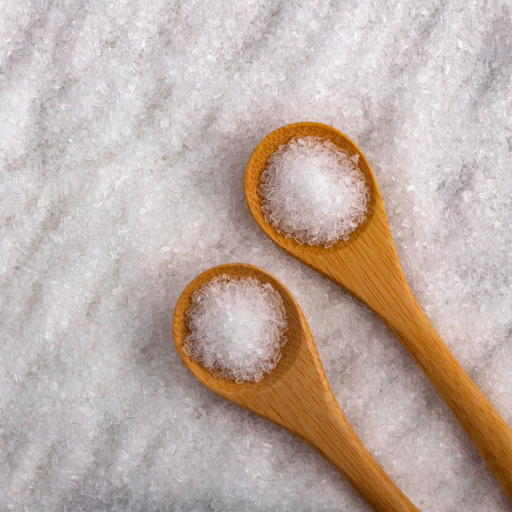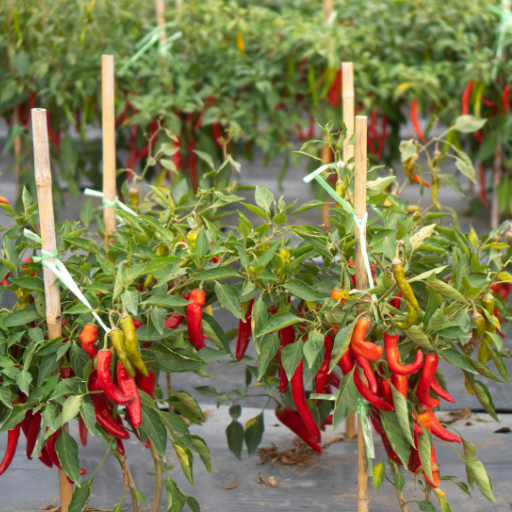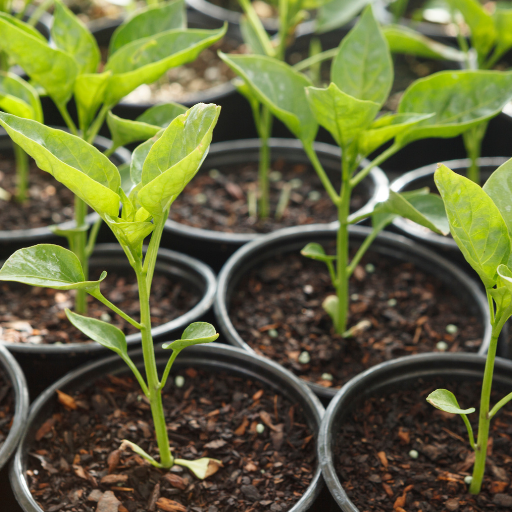Growing peppers, whether in a garden or a controlled environment, requires careful attention to soil composition and nutrient management to achieve optimal yield and plant health. Keeping strict control over nutrients and soil quality is important if you are growing peppers. One highly effective method for enhancing pepper growth is the disciplined use of Epsom salt, a naturally occurring mineral of hydrated magnesium sulfate. Magnesium is one of the most important parts of that element needed by plants in photosynthesis since it supports chlorophyll production, while sulfur helps in some other vital plant functions. Discussed in this blog will be the benefits associated with using Epsom salt as part of your pepper cultivation practices so that you can have an extensive understanding as well as practical ideas on how to improve your pepper crops’ yields towards their fullest potential. With scientific principles intertwined with down-to-earth counsel, this guide aims at enriching both learners and experts on how to better their efforts in growing peppers through increased awareness.
What is Epsom Salt and Why Use It?

The mineral compound Epsom salt, which is also called magnesium sulfate heptahydrate (MgSO₄·7H₂O) owing to its high solubility in water, serves as an important nutrient supplement in horticulture because of its high content of magnesium and sulfur, both of which are essential for plants’ health. Photosynthesis plays a key role by being part of the chlorophyll molecule that enables a plant to convert solar energy into chemical energy. Conversely, Sulfur is required for protein synthesis and enzyme function. Lime sulphate can be used to correct soil deficiencies such as magnesium deficiency, increase nutrient uptake and improve overall plant performance thus making it as an important tactic whenever growing pepper plants (Capsicum annuum L.).
The Chemical Composition of Epsom Salt
Epsom salt contains specific stoichiometric ratios of magnesium, sulfur and oxygen denoted by the molecular formula MgSO₄·7H₂O. This composition suggests that each molecule of magnesium sulfate is bonded to seven molecules of water, making it a heptahydrate. The molar mass of heptahydrated magnesium sulfate is about 246.48 g/mol. Whereas the molar mass has 9.86% the rest comprises about 60.33% sulfate ion (SO₄²⁻) whereas water makes up 29.81%. These technical specifications are critical for understanding its solubility characteristics when dissolved in soil moisture and the bioavailability properties of magnesium and sulfur ions in soils where it dissolves.Thus, equipped with this information, Epsom salt can be applied suitably with optimal results on plants.
Common Uses of Epsom Salt in Gardening
Epsom salts find diverse applications in gardening due to their chemical features and advantages they offer to plants concerning their health status. One common use is to correct magneisum-deficient soils that exhibit yellow leaves due to impaired chlorophyll synthesis. Typically, gardeners rectify this situation by adding Epsom salt as soil amendment or foliar spray. For soil application, it is recommended that 1 to 2 tablespoons per foot of plant height be mixed into the soil around the base of the plant. When using it as a foliar spray, a solution consisting of 2 tablespoons of Epsom salt for every gallon of water is directly applied on the leaves ensuring quick absorption of magnesium.
Another common application involves promoting germination. Magnesium assists in enzyme activation and thus plays an essential role at early seedling stages. Therefore, soaking seeds in an Epsom salt solution before planting may lead to stronger seedlings with better overall plant development rate.
The application also helps typically heavy feeders such as tomatoes and roses absorb nutrients more efficiently through their root systems. The sulfur in Epsom salts assists amino acid formation, which is a very important constituent for any metabolically active cell and protein synthesis. These growth factors are necessary for growth and development in plants. Regularly applying Epsom salts can result in increased flowering and fruiting as well as greater vigor since plants will have more resources directed towards vegetative growth.
For desirable outcomes, gardeners must evaluate the pH levels and texture types of their soils besides knowing its nutrient status prior to using this additive. It works incredibly well when used on sandy soils or acidic ones where leaching out of magnesium is known to occur most frequently.However, it should not be applied excessively because it can cause nutrient imbalances or toxicity issues.The testing your soil will give you enough information about whether you should apply lime sulphate or not hence this ensures things are done appropriately all the time.
How Does Epsom Salt Benefit Pepper Plants?

The benefits of Epsom salt on pepper plants emanates from its richness in magnesium which is instrumental in the formation of chlorophyll and the well being of the entire plant. Magnesium deficiency often results to yellowing leaves, particularly older foliage, that may impair the process of photosynthesis. Epsom salts addition ensures that pepper plants receive adequate amounts of magnesium which helps in improving leaf coloration and photosynthetic efficiency. Sulfur in Epsom salt is also beneficial as it involves essential amino acids’ production and stimulates healthy root growth. Continuous use of Epsom salts can lead to improved fruit set, increased yields, and better overall plant health.
Enhancing Nutrient Absorption in Peppers
The use of Epsom salt to enhance nutrient absorption in pepper plants involves many technical considerations. Firstly, it is important to understand that magnesium found in Epsom salt aids nitrogen, phosphorous, and other elements responsible for crop development. This can be observed by improved leaf growth and enhanced chlorophyll synthesis since magnesium is part of the chlorophyll molecule.
Secondly, how much should be applied? The recommended rate follows this path where one tablespoonful would apply on top foliar spray or soil drench per each foot tall plant dissolved with water. This should be done every fourteen days during the growing period to ensure enough magnesium (Mg) levels. Soil pH should also be checked regularly so that it does not go beyond 6.0-7.0 mark because at 6-7 the nutrient uptake remains higher.
Additionally, it contains sulphur that promotes the synthesis proteins and essential amino acids for plant metabolism/growth –rendering more robustness to foliage/flower + fruiting-bodies [E} while application of this substance shall enable informed knowledge through conducting soil tests about these vital nutrients; subsequently helping come up with clear facts concerning why an application of Epsom salt was justified in terms of all parameters.
Improving Chlorophyll Production in Pepper Plants
Various factors account for the higher rate of chlorophyll production in pepper plants. Firstly, ensuring sufficient amounts of magnesium is a priority because it is one of the central atoms found on the chlorophyll molecule. On regular basis, apply Epsom salts containing magnesium sulfate which can boost this process (E). Secondly, correct amount of nitrogen is required as it plays a role in forming chlorophyll. Thirdly, appropriate light exposure should be maintained since photosynthesis driven by light results into chlorophyll formation. So far, it is important to maintain soil pH at 6-7 so that nutrients are available for maximal utilization and uptake.
Strengthening Pepper Cell Walls For More Vitality
Strengthening cell walls of pepper plants is crucial in improving their general well-being and sturdiness. In this regard, Epsom salt which is rich in magnesium and sulfur plays a big role. Magnesium is important for the functioning of enzymes that are involved in the development of cell walls. The presence of enough magnesium means that these enzymes can effectively catalyze the synthesis of pectin, an essential ingredient of plant cell wall that makes it rigid and intact. Additionally, proteins and certain amino acids, which are building blocks for cellular structures, require sulfur during synthesis. Therefore, regular applications of Epsom salt can increase structural strength in pepper plants due to thicker and stronger cell walls. This enhances plants’ resistance to environmental stresses as well as reduces vulnerability to diseases from pests. To achieve best outcomes, it is advised that periodic soil tests be carried out to track levels of magnesium and sulfur so they do not go beyond what is required for healthy cell wall growth.
What’s the Best Way to Apply Epsom Salt to Peppers?
For effective application of Epsom salt on pepper plants, it is advisable to use a solution that contains 1 table spoon full of Epsom salt dissolved in one gallon of water. With this solution you can water the plant once every two weeks. Alternatively, Epsom salt may be applied directly around the base of the plants, at a rate of 1 tablespoon per foot in height, and then thoroughly watered. If you want quick effect, foliar feeding can also be used as an application method where similar solution is sprayed directly onto leaves early in the morning or late evening to prevent leaf burn. This way, both roots and foliage will absorb essential magnesium and sulfur, which are necessary for healthy growth and sturdier cell walls.
Using Epsom Salt as a Soil Amendment
Incorporating Epsom salts into the soil is one way to amend it to enhance the magnesium and sulfur content necessary for plants’ growth and developmental stages. The recommended amount of Epsom salts is approximately 1 cup per every 100 square feet of garden soil before planting time ideally. It should, therefore, get mixed thoroughly into the top six to eight inches of soil so that it gets evenly distributed on all parts, including root zones.
Also note that when using Epson salt consider soil pH because it works best at pH ranging from 6.0-7.0.Soil tests help determine current levels for both magnesium and sulphur, hence applying them precisely based on specific records for soil requirements.
As such, established plants require side dressing with Epson salt during growing season whereby every foot high should have one tablespoon with watering afterwards facilitating uptake. Such an approach helps maintain optimum nutrient levels required by viable plants thus improving their yield and vigor over time.
However beneficial it may be, Epson salts tend to cause deficiencies in soils through over-application, resulting in imbalances of nutrients or even degradation due to excessive soil acidity. As a result, the soil must be regularly tested to ensure that it is applied according to the recommended rates, thereby maximizing its advantages without incurring adverse effects.
Making an Epsom Salt Foliar Spray
To create an Epsom salt foliar spray mix 2 tablespoons of Epsom salts with one gallon of water. Pour this mixture into a spray bottle for easy application. For leaf burn prevention purposes, spraying should be done at cooler parts of the days which fall either early in the morning or late afternoon.However, rapid absorption through leaves can still occur when magnesium and sulfur are supplied almost immediately, making foliage greener and enhancing nutrient uptake. Repeated applications may address such shortcomings every two to four weeks but should not lead to overdose as this would disbalance nutrients within plants. The best outcome will be obtained if you sprinkle these substances on the bottom side of the leaves because most stomata are found there; therefore, they can absorb nutrients more easily.
Recommended Dosage and Application Timing
Epsom salt application at appropriate amount significantly benefits growth and yield optimization among pepper plants. Here is how much Epsom salt you should apply for pepper plants:
- Pre-planting: At the planting site, incorporate 1 tablespoon of Epsom salt per square foot of soil, thoroughly mixing to ensure even distribution and increased root uptake.
- Transplanting: During transplanting of pepper seedlings, add one tablespoon of Epsom salt in the planting hole and lightly cover with soil before planting the seedling; this will help reduce transplantation suffering and promote rapid development of the root system.
- Growing Season: In this growing season apply magnesium sulphate as a side dressing at a rate of one tablespoon per foot high once every month. Gently mix the granules into the soil and then water thoroughly to enhance absorption of nutrients.
- Foliar Spray: For a faster nutrient boost, use an Epsom salt foliar spray mentioned in detail previously. This solution can be applied every two to four weeks, especially if there are signs of magnesium deficiency, including pale leaves.
Timing is crucial when applying Epsom salt. It should be applied early in the morning or late in the evening so as to avoid hottest parts of day that may result to burning leafs and reduced effectiveness on uptake of nutrients.Regularly checking on plants’ progress as well as testing soils goes a long way towards perfecting application schedules and dosage for an even supply of nutrients across different growth stages, which enhances better foliage, flowering, and fruiting, resulting in improved overall performance health-wise, such as stronger vegetative leafy part and higher productivity levels for the peppers.
What Should You Watch Out for When Using Epsom Salt?

Great care should be taken when using Epsom salt so as to prevent excess application that may cause soil nutrient imbalance and plant damage. Overdosing of Epsom salt can result in high levels of magnesium in the soil that may hamper the absorption of other essential nutrients such as calcium and potassium. In addition, always ensure to dissolve your foliar completely. Spray Epsom salt before use to avoid leaf burn and tissue destruction, which can occur if it is not properly dissolved. It is also advisable to conduct periodic tests for soil magnesium levels so as to prevent deficiencies or applying Epsom salts near water bodies as this may lead to aquatic pollution and disturbance of ecosystems.
How to detect overuse
Several symptoms associated with excessive use of Epsom salts indicate both plant health problems and soil degradation. First, some leaf scorching or burning cases can be noted by brownish or crispy edges on leaves. This happens because too much magnesium interferes with calcium uptake resulting in cellular collapse and leaf necrosis. Another observation could be stunted growth due to unbalanced minerals within the soil, which make potassium deficiency a major problem since it is needed for enzyme activation and photosynthesis, among other physiological functions.
In another case, chlorosis occurs when leaves turn yellow but veins remain green, indicating a lack of iron and nitrogen, which are necessary for chlorophyll synthesis. Additionally, an increase in magnesium levels within the soil results in poor root development due to reduced availability of calcium, which is important for root elongation and supportiveness.
Technically speaking, balancing out excessive supply of Epsom salts means closely monitoring Soil CEC (Cation Exchange Capacity). A CEC value beyond optimum values (as low as 10 meq/100g up to 20 meq/100g) would imply oversaturation with Mg ions. Routine analysis for magnesium concentration in the soil (optimum range: 50-120 ppm) can also help confirm this and modify fertilization practices accordingly. Moreover, maintaining the soil pH at 6.0-6.5 range would ensure that all essential nutrients are available in the right quantities. These parameters will reduce negative impacts of Epsom salt overuse and support sustainable plant health management.
Balancing Epsom Salt with Other Nutrients
Balancing Epsom salt with other nutrients is a matter of understanding plant physiology as well as soil chemistry in depth. First and foremost, it should be realized that Epsom salts predominantly supply magnesium and sulfur in quantities that need to be adjusted depending on other macronutrients and micronutrient levels to avoid their negative impact. According to studies, an optimum range for magnesium concentration in soils should lie between 25-50 ppm so as not to cause any nutrient lock-out. Additionally, sulfur content should fall within 10-30 ppm.
The magnesium to calcium or potassium ratio is a major component to consider when balancing Epsom salt with these elements. Thus, an ideal soil has a Ca:Mg ratio of about 6:5:1 and an Mg:K ratio of around 8:4:1 (magnesium/calcium/magnesium/potassium, respectively). Therefore, variations from these ratios may result into mineral imbalances. Despite this increased amounts of magnesium may disrupt calcium and potassium uptake; however if maintained, these ratios will prevent any one element being overly abundant relative to others thereby preventing deficiencies.
To obtain a balanced nutrient profile, close monitoring of soil pH is necessary. It should be kept between 6.0 and 7.0 because most essential nutrients are optimally available within this range. Soil pH can be adjusted by adding lime to raise it or sulfur to lower it, as indicated by current measurements.
Regular soil testing is important for managing nutrient levels. The tests should measure cation exchange capacity (CEC), which shows how well the soil can hold on to essential nutrients. Most soils require a CEC range of 10 – 20 meq/100g, ensuring sufficient nutrient-holding ability without overloading them.
Adhering to these technical parameters and constantly monitoring soil condition could effectively balance Epsom salt application with other essential plant nutrients while maintaining optimal plant health and growth.
The Significance of Soil Testing & pH Balance
Soil testing forms an integral part of good soil management practices; providing accurate information about the types of nutrients present in the soil as well as its general wellness. This will assist farmers in knowing the level of acidity, whether there are any deficiencies in terms of nutrients or toxicities or imbalances occur in their soils, by which gardeners will make regular analysis through soil sampling techniques aimed at determining pH levels. Soil ph must be maintained within certain limits since it affects availability of essential elements for plants. When balanced, ph prevents nutrient lock-up and excessive release both being detrimental to crop growth and development. Moreover, proper use of fertilizers based on specific needs allows farming systems to grow crops that are directly proportional to agriculture income rather than experiencing low yields all along consecutively year after year. Sustainable, productive agricultures thrive under consistent examination with recommended rectifications concerning the maintenance of healthier soils throughout each cropping season.
How to Identify and Treat Nutrient Deficiencies in Peppers

Pepper plant nutrient deficiencies often have specific symptoms that are unique to them. For instance, nitrogen deficiency is marked by pale green or yellowing leaves, primarily on older leaves first. Treatment involves using a balanced fertilizer which is rich in nitrogen. Stunted growth and deep purple coloration on the undersides of leaves identify phosphorus deficiency. To rectify this problem, use a fertilizer high in phosphorus or add bone meal to the soil. Yellowing along leaf edges and brown spots may be observed in potassium-deficient plants. This shortage can be addressed by applying a potassium specific fertilizer such as potassium sulfate. Also remember that lack of calcium leads to blossom end rot where water-soaked spots progress into sunken, black lesions on fruits. Mitigate this problem by amending the soil with lime or using a calcium foliar spray. Healthy pepper plants with optimum productivity can only be realized when nutrients levels are continuously adjusted based on soil tests.
Identifying Magnesium Deficiency in Peppers
The appearance of interveinal chlorosis indicates magnesium deficiency in peppers where the areas between veins turn yellow while veins remain green for example on old leaves called necrosis if not treated impends stemming from this condition becomes root cause because magnesium is an integral part of chlorophyll molecule without which photosynthesis cannot take place The optimal soil magnesium levels should be between 25-50 ppm as per standard soil test recommendations Some farmers apply Epsom salt (magnesium sulfate) as either a foliar spray containing 1-2 tablespoons per gallon of water or a soil amendment This helps ensure that magnesium levels remain within acceptable limits hence avoiding its deficiency and maintaining strong healthy pepper plants
Symptoms of Sulfur Deficiency in Pepper Plants
Yellowing progresses uniformly over entire leaf surface without interveinal patterns in sulfur deficient pepper plants, unlike nitrogen which is confined mainly to their older leaves However, stunted growth and late maturity are often due to this deficiency because sulfur is necessary for the formation of amino acids and proteins, which are important for plant growth and development According to agricultural guidelines, sulfur in soil should range between 10-30 ppm. Elemental sulfur or fertilizers containing sulfur such as ammonium sulfate can be used to correct sulfur deficiency Use of gypsum (calcium sulfate) allows increasing levels of sulfur without significantly changing soil pH Regular soil testing with recommended rates of sulfur amendments
How Epsom Salt Addresses These Deficiencies
Epsom salt (magnesium sulfate) contains magnesium and sulfur, which is why it can help with dealing with a lack of magnesium and sulphur. It contains 9.8% magnesium and 13% sulphur, which makes it a good amendment for adding these vital nutrients to the soil. When applied as a soil amendment, Epsom salt dissolves rapidly, releasing magnesium and sulphur ions that are immediately taken up by plants.
In case you have a problem with magnesium shortage in your crops, usually you should take about one or two tablespoons of an Epsom salt per gallon water as a foliar spray so that there is an immediate absorption through leaves, hence quick recovery from this The optimal level of magnesium required for pepper plant health according to standard agricultural guidelines is within 25-50 ppm
If sulphur levels are low, Epsom salt can be applied directly to the soil at a rate of 1-2 tablespoons per square foot, with thorough mixing to enhance its availability in the sulphur. The best soil content for sulphur, as recommended by agricultural standards, ranges from 10-30 ppm.
To maintain pepper plants’ good health and robust growth, it is possible to effectively maintain magnesium and sulfur levels by including Epsom salt in regular soil management.
How to Optimize Pepper Plant Growth with Epsom Salt

To make sure that Epsom salt optimizes the growth of pepper plants, it is important to understand its correct use and application timing. To determine the present levels of magnesium and sulfur, which can result in nutrient imbalances if it is excessively applied, start by testing the soil. A foliar spray should be mixed with 1-2 tablespoons of Epsom salt per gallon of water for bi-weekly application during the growing season if any deficiencies are found. Nutrient-rich environment can also be created by integrating 1-2 tablespoons of Epsom salt into planting soils per square foot. By monitoring plant health and soil conditions you will always maintain effective Epsom salts application that will promote optimal growth.
Introduce Epsom Salt into Your Gardening Practices
Incorporating Epsom salt into gardening routines helps provide much-needed magnesium and sulfur for plant wellness. A soil nutrient level test should be done to avoid over-application when incorporating Epsom salt effectively. Make a foliar spray by dissolving 1-2 tablespoons in a gallon of water for general plant maintenance purposes, then apply bi-weekly. Alternatively, mix one tablespoon per square foot or monthly through out the growing season for soil applications during planting. These practices enhance chlorophyll production and enzyme function, promoting robust growth and higher yields.
Check Plant Health and Modify Applications
Regular check-ups on plant health are necessary for proper adjustment on applications regarding Epsom salt concentration.Whether leaves become yellow with green veins (chlorosis), show slow development, or even curl at their edges, indicating magnesium deficiency.Soil pH needs periodic testing because extremely acidic or alkaline conditions affect nutrient availability.Soil testing kits are useful in measuring nutrient levels to ensure balanced fertilization.If the initial remedy fails to address this situation, increase the concentration slightly to one tablespoon per gallon while applying foliar sprays or per square foot in case of soil applications. By maintaining continuous checks and making accurate alterations, you can sustain the best productivity and health for your plants.
Long-term Advantages of Regular Usage of Epsom Salt
Regular usage of epsom salt in gardens has numerous benefits that enhance sustainable plant health and soil stability. Magnesium, which is a component of Epsom salt, plays an important role in photosynthesis by aiding chlorophyll formation, hence resulting in greener and stronger foliage. It also helps in nutrient uptake by promoting absorption of critical nutrients such as nitrates, phosphorus, and potassium into the plant thus encouraging healthier growth patterns plus higher yields. Continuous applications can help to improve soil quality through breaking compacted soils that encourage root development as well as water penetration.Ensuring that it’s applied constantly in measured quantities makes plants become stronger with better growth, improved disease resistance and high yields over time.
Reference sources
Frequently Asked Questions (FAQs)
Q: How does using Epsom salt benefit pepper plants?
A: Epsom salt for peppers helps by providing magnesium, which is essential for photosynthesis and overall plant health. Applying Epsom salt helps pepper plants produce more vibrant foliage and better yields.
Q: How do I apply Epsom salt to pepper plants?
A: You can apply Epsom salt in the garden by mixing two tablespoons of Epsom salt into a gallon of water and watering your pepper plants with it every 3-4 weeks. Alternatively, you can use a tank sprayer for foliar feeding by dissolving one tablespoon in a gallon of water and spraying the leaves.
Q: Can Epsom salt be used as a fertilizer for my vegetable garden?
A: Yes, Epsom salt is a natural mineral that provides magnesium and sulfur, which are essential nutrients. However, it should complement organic fertilizers, not replace them, to ensure balanced nutrition for your vegetable garden.
Q: How often should I apply Epsom salt to my pepper plants?
A: For best results, apply a solution of two tablespoons of Epsom salt to a gallon of water every 3-4 weeks during the growing season to provide consistent magnesium to the plants.
Q: Can I use Epsom salt for foliar feeding?
A: Yes, you can use Epsom salt for plants as a foliar spray. Dissolve one tablespoon of Epsom salt in a gallon of water and spray the mixture onto the leaves, which allows for quick absorption and helps address magnesium deficiencies.
Q: Are there any risks of using too much Epsom salt for peppers?
A: Over-application of Epsom salt can lead to soil imbalances and potentially harm the plant. It’s important to follow recommended dosages, such as two tablespoons of Epsom salt per gallon of water every few weeks, to avoid potential issues.
Q: Is Epsom salt a substitute for organic fertilizers in my garden?
A: No, Epsom salt is not a substitute for comprehensive organic fertilizers. While Epsom salt provides essential magnesium, your plants still need a balanced diet of nutrients, which organic fertilizers offer.
Q: What is the ideal concentration of Epsom salt to use for peppers?
A: A common and effective concentration for pepper plants is two tablespoons of Epsom salt mixed in a gallon of water. This solution can be applied as a soil drench or via foliar feeding.
Q: How does Epsom salt help tomatoes in addition to peppers?
A: Like with pepper plants, Epsom salt helps tomatoes by supplying magnesium, which enhances photosynthesis and encourages strong growth. Tomatoes, much like peppers, benefit from a magnesium-rich environment for better fruit production.
Q: Will Epsom salt improve the overall health of my garden plants?
A: Epsom salt helps provide essential magnesium and sulfur, which can improve the overall health and vigor of garden plants. However, it should be used as part of a broader fertilization plan that includes other nutrients.






